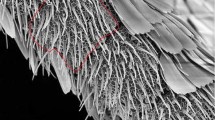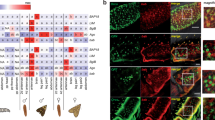Abstract
The short-term evolutionary effect of pheromone-based mating disruption on the mating ability of the Indian meal moth, Plodia interpunctella, was investigated. Three independent selection lines were established, and the mating ability of moths in plastic tents treated with high doses of pheromone and in control tents was compared for two consecutive generations. In addition, the heritability of the sex pheromone blend, measured as the ratio of two major pheromone components (Z,E)-9,12-tetradecadienyl acetate and (Z,E)-9,12-tetradecadienol, was estimated. Based on a mother–daughter regression analysis including 21 families, the heritability of the pheromone blend was 0.65 ± 0.14, indicating a potential for evolutionary change of the character. However, no increase in mating ability of females in pheromone-treated tents or alteration of the pheromone blend was observed in any selection line when compared with control lines, indicating no or weak selection on the pheromone blend as well as other traits influencing mating ability of this species under the created mating disruption conditions. Factors contributing to the lack of selection effects are discussed.
Similar content being viewed by others
REFERENCES
Barrer, P. M., Lacey, M. J., and Shani, A.1987. Variation in relative quantities of airborne sex pheromone components from individual females Ephestia cautella(Lepidoptera: Pyralidae). J. Chem. Ecol. 13:639–653.
CardÉ, R. T. and Minks, A. K.1995. Control of moth pests by mating disruption: Successes and constraints. Annu. Rev. Entomol. 40:559–585.
Collins, R. D. and CardÉ, R. T.1989. Selection for altered pheromone-component ratios in the pink bollworm moth, Pectinophora gossypiella(Lepidoptera: Gelechiidae). J. Insect Behav.2:609–621.
Collins, R. D. and CardÉ, R. T.1990. Selection for increased pheromone response in the pink bollworm, Pectinophora gossypiella(Lepidoptera: Gelechiidae). Behav. Genet. 2:325–331.
Collins, R. D., Rosenblum, S. L., and CardÉ, R. T.1990. Selection for increased pheromone titre in the pink bollworm moth, Pectinophora gossypiella(Lepidoptera: Gelechiidae). Physiol. Entomol. 15:141–147.
Du, J.-W., LÖfstedt, C., and LÖfqvist, J.1987. Repeatability of pheromone emission from individual female ermine moths Yponomeuta padellusand Yponomeuta rorellus. J. Chem. Ecol. 13:1431–1441.
Evenden, M. L. and Haynes, K. F.2001. Potential for the evolution of resistance to pheromone-based mating disruption tested using two pheromone strains of the cabbage looper, Trichoplusia ni. Entomol. Exp. Appl. 100:131–134.
Falconer, D. S. and Mackay, T. F. C.1996. Introduction to Quantitative Genetics, 4th ed. Longman, New York.
Foster, S. P., Muggleston, S. J., LÖfstedt, C., and Hansson, B. S.1996. A genetic study on pheromonal communication in two Ctenopseustismoths, pp. 514–524, inR. T. Cardé and K. Minks (eds.). Insect Pheromone Research: New Directions. Chapman & Hall, New York.
Gemeno, C., Lutfallah, A. F., and Haynes, K. F.2000. Pheromone blend variation and crossattraction among populations of the black cutworm moth (Lepidoptera: Noctuidae). Annu. Entomol. Soc. Am. 93:1322–1328.
Gemeno, C., Moore, A. J., Preziosi, R. F., and Haynes, K. F.2001. Quantitative genetics of signal evolution: A comparison of the pheromonal signal in two populations of cabbage looper, Trichoplusia ni. Behav. Genet.31:157–165.
Haynes, K. F. and Baker, T. C.1988. Potential for evolution of resistance to pheromones:Worldwide and local variation in chemical communication system of pink bollworm moth, Pectinophora gossypiella. J. Chem. Ecol. 14:1547–1560.
Haynes, K. F. and Hunt, R. E.1990. A mutation in pheromonal communication system of Cabbage looper moth, Trichoplusia ni. J. Chem. Ecol. 16:1249–1257.
Hunt, R. E., Zhao, B.-G., and Haynes, K. F.1990. Genetic aspects of interpopulational differences in pheromone blend of cabbage looper moth, Trichoplusia ni. J. Chem. Ecol. 16:2935–2946.
Kuwahara, Y. and Casida, J. E.1973. Quantitative analysis of the sex pheromone of several phyctid moths by electron-capture gas chromatography. Agric. Biol. Chem. 37:681–684.
Kuwahara, Y., Hara, H., Ishii, S., and Fukami, H.1971. Sex pheromone of the almond moth and the Indian meal moth: cis-9,trans-12-tetradecadienyl acetate. Science171:801–802.
LaForest, S., Wu, W. Q., and LÖfstedt, C.1997. A genetical analysis of population differences in pheromone production and response between two populations of the turnip moth, Agrotis segetum. J. Chem. Ecol. 23:1487–1504.
Liu, Y.-B. and Haynes, K. F.1994. Evolution of behavioral responses to sex pheromone in mutant laboratory colonies of Trichoplusia ni. J. Chem. Ecol. 20:231–238.
LÖfstedt, C.1990. Population variation and genetic control of pheromone communication systems in moths. Entomol. Exp. Appl. 54:199–218.
Mafra-Neto, A. and Baker, T. C.1996. Timed, metered sprays of pheromone disrupt mating of Cadra cautella(Lepidoptera: Pyralidae) J. Agric. Entomol. 13:149–168.
McLaughlin, J. R.1982. Behavioral effect of a sex pheromone extracted from forewings of male Plodia interpunctella. Environ. Entomol. 11:378–380.
McNeil, J. N.1992. Evolutionary perspectives and insect pest control: An attractive blend for the deployment of semiochemicals in management programs, pp. 334–351, inB. D. Roitberg and M. B. Isman (eds.). Insect Chemical Ecology: An Evolutionary Approach. Chapman & Hall, New York.
Minks, A. K. and CardÉ, R. T.1988. Disruption of pheromone communication in moths: Is the natural blend really most efficacious? Entomol. Exp. Appl. 49:25–36.
Roleofs, W. L., Du, J.-W., Linn, C., Glover, T. J., and Bjostad, L. B.1986. The potential for genetic manipulation of the redbanded leafroller moth sex pheromone blend, pp. 263–272, inM. D. Huettel (ed.). Evolutionary Genetics of Invertebrate Behavior, Plenum Publishers, New York.
Roelofs, W. L., Glover, T., Tang, X.-H., Sreng, I., Robbins, P., Eckenrode, C., LÖfstedt, C., Hansson, B. S., and Bengtsson, B. O.1987. Sex pheromone production and perception in European corn borer moths is determined by both autosomal and sex-linked genes. Proc. Natl. Acad. Sci. USA84:7585–7589.
Ryne, C., Svensson, G. P., and LÖfstedt, C.2001. Small-scale mating disruption experiments of Plodia interpunctella: Effect of pheromone blends, doses and population densities. J. Chem. Ecol.27:2109–2124.
Shani, A. and Clearwater, J.2001. Evasion of mating disruption in Ephestia cautella(Walker) by increased pheromone production relative to that of undisrupted populations. J. Stored Prod. Res. 37:237–252.
Sower, L. L., Vick, K. W., and Tumlinson, J. H.1974. (Z,E)-9,12-Tetradecadien-1-ol: A chemical released by female Plodia interpunctellathat inhibits the sex pheromone response of male Cadra cautella. Environ. Entomol. 3:120–122.
Sreng, I., Glover, T., and Roleofs, W.1989. Canalization of the redbanded leafroller moth sex pheromone blend. Arch. Insect Biochem. Physiol. 10:73–82.
Svensson, M. G. E., Bengtsson, M., and LÖfqvist, J.1997. Individual variation and repeatability of sex pheromone emission of female turnip moths Agrotis segetum. J. Chem. Ecol. 23:1833–1849.
Teal, P. E. A., Heath, R. R., Dueben, B. D., Coffelt, J. A., and Vick, K. W.1995. Production and release of (Z,E)-tetradecadienal by sex pheromone glands of females of Plodia interpunctella(Lepidoptera: Pyralidae). J. Chem. Ecol. 21:787–800.
Torres-Vila, L. M., Stockel, J., Lecharpentier, P., and RodrÍguez-Molina, M.C.1997. Artificial selection in pheromone permeated air increases mating ability of the European grape vine moth Lobesia botrana(Lep.,Tortricidae). J. Appl. Entomol. 121:189–194.
Trematerra, P. and Pavan, G.1995. Ultrasound production in the courtship behaviour of Ephestia cautella(Walk.), E: kuehniellaZ. and Plodia interpunctella(Hb.) (Lepidoptera: Pyralidae). J. Stored Prod. Res. 31:43–48.
Vick, K. W., Coffelt, J. A., Mankin, R. W., and Soderstrom, E. L.1981. Recent developments in the use of the pheromones to monitor Plodia interpunctellaand Ephestia cautella, pp. 19–28, inE. R. Mitchell (ed.). Management of Insect Pests with Semiochemicals. Plenum Publishing, New York.
Witzgall, P. and FrÉrot, B.1989. Pheromone emission by individual females of the carnation tortrix, Cacoecimorpha pronubana. J. Chem. Ecol. 15:707–717.
Zhu, J.-W., Ryne, C., Unelius, R., Valeur, P. G., and LÖfstedt, C.1999. Reidentification of the female sex pheromone of the Indian meal moth, Plodia interpunctella: Evidence for a fourcomponent pheromone blend. Entomol. Exp. Appl. 92:137–146.
Author information
Authors and Affiliations
Corresponding author
Rights and permissions
About this article
Cite this article
Svensson, G.P., Ryne, C. & Löfstedt, C. Heritable Variation of Sex Pheromone Composition and the Potential for Evolution of Resistance to Pheromone-Based Control of the Indian Meal Moth, Plodia Interpunctella . J Chem Ecol 28, 1447–1461 (2002). https://doi.org/10.1023/A:1016204820674
Issue Date:
DOI: https://doi.org/10.1023/A:1016204820674




